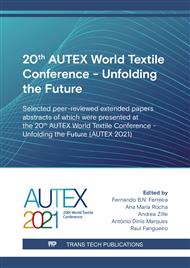[1]
ATP – Associação Têxtil e Vestuário de Portugal, Fashion From Portugal Diretório 2019, ATP, V.N. Famalicão, (2019).
Google Scholar
[2]
ATP – Associação Têxtil e Vestuário de Portugal, Fashion From Portugal. Yearbook. Textile and Clothing Industry Statistics: World, Europe and Portugal, ATP, V.N. Famalicão, (2017).
Google Scholar
[3]
Almeida, Maria Inês, Valérius Growth Trajectory – A Case Study on Competitive Advantage in the Portuguese Textile and Clothing Industry, UCP, Lisboa, (2018).
Google Scholar
[4]
Foss, N., Resources, Firms, and Strategies: A Reader in the Resource-based Perspective, Oxford University Press, New York, (1997).
Google Scholar
[5]
Cardeal, N., Pensamento Estratégico, Universidade Católica Portuguesa, Lisboa, (2014).
Google Scholar
[6]
Peteraf, M. & Barney, J., Unraveling the resource-based tangle, Managerial and Decision Economics, Vol. 24, Issue 4, 2003, 309–323.
DOI: 10.1002/mde.1126
Google Scholar
[7]
Hambrick, C., Upper echalons theory: an update, Academy of Management Review, Vol. 32, No. 2, April 2007, 334-343.
Google Scholar
[8]
Teece, D., Pisano, G., & Shuen, A., Dynamic Capabilities and Strategic Management, Strategic Management Journal, Vol. 18., No. 7, 1997, 509-533.
DOI: 10.1002/(sici)1097-0266(199708)18:7<509::aid-smj882>3.0.co;2-z
Google Scholar
[9]
Helfat, C. et al., Dynamic Capabilities: Understanding Strategic Change in Organisations, Blackwell, Malden, MA, 2007.
Monitor Company, Construir as Vantagens Competitivas de Portugal, Edição Fórum da Competitividade, Lisboa, (1994).
DOI: 10.7559/gestaoedesenvolvimento.1994.200
Google Scholar
[10]
Grant, M., Toward a Knownledge-based theory of the firm, Strategic Management Journal, Summer Special Issue 17, 1996, 109-112.
Google Scholar
[11]
Pisano, P., Knowledge, integration, and focus of learning: an empirical analysis of process development, Strategic Management Journal, Winter Special Issue 15, 1994, 85-100.
Google Scholar
[12]
Godet, M., A Prospetiva Estratégica Para as Empresas e Territórios, Unesco/Dunod, Paris, (2011).
Google Scholar
[13]
Sauders, Mark, Lewis, Philip & Thornhill, Adrian, Research Methods for Business Students, 5th Ed., Finantial Times Prentice-Hall, London, (2009).
Google Scholar
[14]
Robson, Colin, Real world research: a resource for social scientists and practitiorer- researchers, 2nd Ed., Blackwell Publishers Inc., Oxford, (2002).
Google Scholar
[15]
Yin, Robert K., Case Study Research: Design and Methods, 4th Ed., Sage Publications, London, (2009).
Google Scholar
[16]
Stake, Robert E., A Arte de Investigação em estudo de casos, 2a. Ed., Fundação Calouste Gulbenkian, Lisboa, (2009).
Google Scholar



